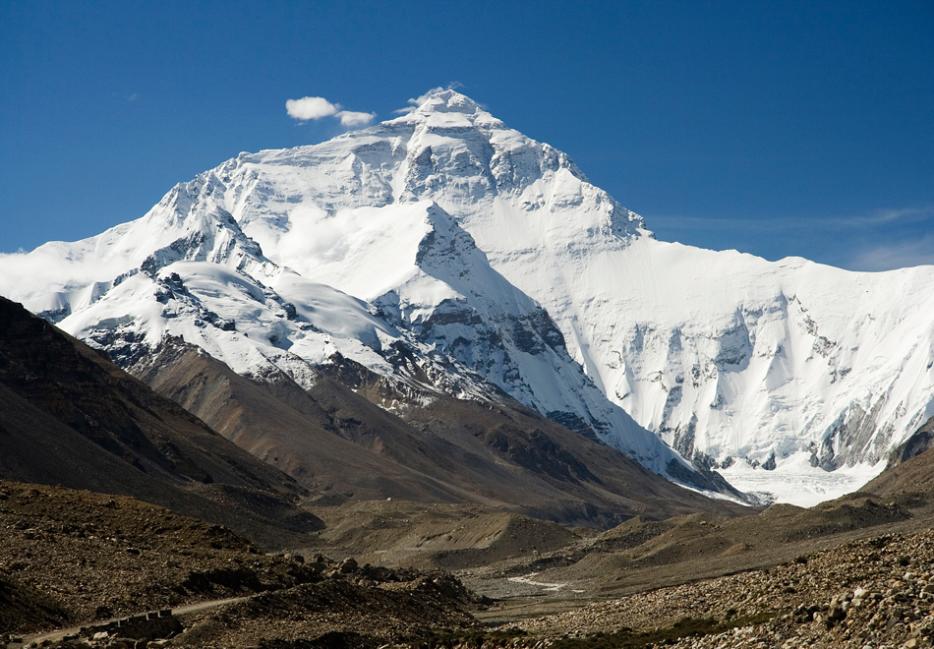In 1922, the second of three successive British expeditions to summit Everest was stuck. Though they had managed to get higher up the mountain than anyone previous—well, higher than anyone who had bothered to keep track, but at this point climbing the mountain was almost exclusively a British obsession, so it was a safe assumption—after two attempts, one of which got them to a new record of 8,230 metres, they still sat frustratingly below the peak. For George Mallory, one of the bravest and most elegant climbers on the team, if not necessarily the wisest, this would not stand: this was the second time he had gotten most of the way to the top, and that simply wasn't good enough for him.
He led a small group on the expedition’s third attempt. Aiming for expediency, he tried to force his way up as quickly as possible, avoiding the softer climbs the group had tried before. This urgency proved disastrous; unable to hold the weight of the climbers, the steep ice collapsed into an avalanche, killing seven and ending the 1922 expedition’s attempts for good. Displaying the plucky dauntlessness that was so crucial to the British character in the latter days of empire, the avalanche was announced to the rest of the world with the relieved words, “All whites are safe!” As with last week’s disaster, their Nepalese porters took the entirety of the mountain’s wrath, including one whose body was never recovered.
The expedition wound up giving the world a much more famous phrase about Everest. On a hero-making North American tour organized after the disaster, Mallory was asked why anyone would even want to climb Everest. His response—which almost certainly doesn’t need to be repeated, but will be, endlessly—is the molecular version of man’s indomitable will to explore: “Because it’s there.”
Presumably Everest is no less there for the people who live at its base: if anything, it is more there, more than just a place to plant flag and prove mettle. As Wade Davis explains in his recounting of the 1920s British expeditions up Everest, Into the Silence, the locals regarded the exploratory Brits essentially as madmen. The mountain was a sacred place, and would not be any more so if you stood on top of it. One local lama, writing in his diary, openly pitied the British mountaineers: “I felt great compassion for them to suffer so much for such meaningless work.”
Meaning is always in the eye of the beholder, though. As Davis points out, almost all of the mountaineers across the three expeditions were veterans of World War I. He views the summiting of Everest as a kind of atonement for the horror civilization had just wrought, proof that British drive and ingenuity could be used for something better than industrial-strength killing. Others have pointed out that the British, after having lost out on both the north and south poles, saw Everest as a “third pole”: a 8,848-metre dick to bring to the explorers’ measuring contest, as it were.
But to even talk about the British here is a slight misnomer: the people making these climbs were so rarefied and refined they made special provisions to carry 60 tins of quail packed in foie gras and 48 bottles of 1915 Montebello champagne. The foie gras did not weigh down their spirit, at least: Mallory made another attempt at the summit in 1924, and may have even actually reached it, though that claim is hard to verify given that he froze to death near the peak. (His body was eventually found in 1999.)
If these attempts at reaching the top of the world are rife with haughtiness and imperial bluster, though, at least they had the veneer, however thin, of trying to do something that humanity so far hadn’t. By virtue of following in their footsteps, today’s Everest climbers are markedly less imperial, though no less ridiculous.
The commercialization of climbing Everest has been a sore spot for hearty mountaineers and the more distantly concerned ever since the release of Into Thin Air, Jon Krakauer’s book about a disastrous 1996 climb (which, until last week, featured the biggest single-day death toll on the mountain). There is a certain macho undercurrent to the complaints—a lot of true-blue climbers grumbling about people paying up to $100,000 to be all but carried up the slopes by their guides—but the effects ripple out beyond those with narrower chests getting to see the peak.
Everest has become something of a garbage dump, with climbers discarding everything from wrappers to oxygen bottles en route to the top. And littering is often the least of the sins committed as base camp: in his book High Crimes, Michael Kodas details everything from hash and whores (climbers are not fabulously language sensitive) in the camps to porters and climbers essentially relying on being able to steal supplies from other groups on their way up the mountain. He also details the case of David Sharp, who froze to death in a cave within reaching distance of the main ascent route, climbers either not noticing him or worried that assisting him might ruin their own (rather expensive) shot at the top.
These effects have not gone unnoticed by the people who still consider the mountain a special place. In the lead-up to the 50th anniversary of Edmund Hillary’s successful climb, the man himself called for a break, or at least a slow-down, in climbing attempts. The Nepalese steward of expeditions up Everest’s southern slope, Bhumi Lal Lama, powerlessly agreed: “He’s right. But we are not in a position to give Everest a rest. We will be missing out on royalties. We can’t afford that.”
They’d only be missing out on more now: fully 80% of the more than 5,500 successful summits of Everest have happened since he said that. China was supposedly considering building a guardrail when it took the Olympic torch up the mountain on the road to the 2008 Beijing Olympics. They didn’t, of course, but the mountain, and all the reason we could ever need to climb it, are still there.





